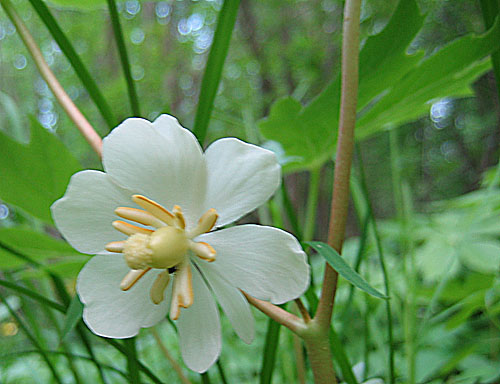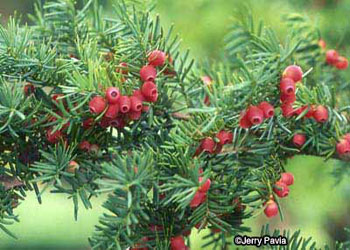In the late 1950's the National Cancer Institute and USDA began to research plants that have anticancer properties. Thousands of different kinds of plants have been screened by scientists and several such as: Periwinkle, Mayapple, and Yew became actual cancer treatments. Plant biomanufacturing is being further developed today and in the future it can be developed into an effective, inexpensive cancer treatment. |
||||
Periwinkle:  Periwinkle is classified as Vinca Rosea and it is originally found in the island of Madagascar. Periwinkle has been used for centuries to treat various conditions and diseases. It was used to treat wasp stings, stop bleeding, cough remedy for sore throats, and a remedy to treat eye infections. Researchers noticed the plant in the 1950's when they learned that Jamaicans used periwinkle tea to treat diabetes. University of Western Ontario and Eli Lilly Pharmaceuticals began the research on periwinkle. These researchers injected periwinkle in mice that were infected with leukemia; 60-80% of these mice experienced prolonged life. Periwinkle has been identified to to have over 70 alkaloids that are used in chemotherapy. Periwinkle vincristine has been very effective for treating acute children leukemia as well as Hodgkin's disease. This plant gave researchers hope that some types of cancer can be overcome by simple chemotherapy. |
Mayapple:  Mayapple is a plant in the barberry family(Berberidaceae). It is found in woodlands in Canada and the Eastern U.S. Mayapple has a medical history among Native American tribes. Its rhizomes were collected in the autumn and dried to make powder. The powder was mixed with liquid and drank as a laxative to get rid of intestinal worms. Mayapple is high in toxins and is know to be poisonous to humans. This plant has been rated "unsafe" for use. Resin from mayapple is used in cream to treat cancerous tumors and genital warts. The most important part of mayapple is the rhizome. The rhizome forms a type of phenolic called the lignan. Lingnants have been the focus of recent work as anti-cancer compounds. Podophyllotoxin is also made from mayapple; it acts as a cell poison for cells undergoing mitosis. It is not used in chemotherapy bacause it is toxic. Etoposide and teniposite are made from phyllotoxin that are much less toxic and are widely used in chemotherapy. Today, USDA scientists are still trying to develop more cancer treatments from mayapple. |
Yew:  Yew belongs to the genus Taxus in the family Taxaceae. After fertilization, the ovule develops into a seed. Yew is a poisonous plant; arils are the only part of the plant that is not poisonous. Yew is extremely popular with the woodworkers and furniture makers; therefore, it is declining in number. The bark of the yew tree is used for developing a drug called taxol. Taxol is probably the most significant drug developed through the NCI-USPA program. In the mid 70s tests showed that taxel had an effect against several human tumor lines. In 1987, taxel showed activity against Ovarian cancer. However, the declining number of yew developed a public concern that there is not enough trees to threat patients. Scientists began to look for other materials and ways to develop taxol in order to peserve yew. Scientists used the molecule in needles from a plant that is similar to yew called Taxus baccata. This led to a second, sucessful development of a second anti-cancer compound, docetaxel. |
||